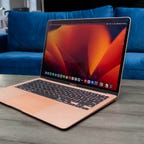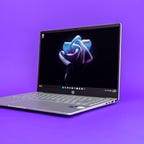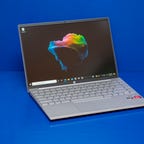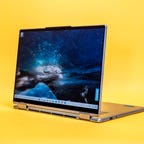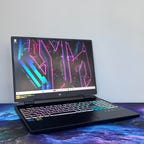Best Laptop for College in 2024
No matter what you're studying, you'll want the right laptop to get through college. We've tested the top laptop brands to find the best laptops for college students.
What to consider
Our Picks
What's the best laptop for college?
Despite passing its third birthday, Apple's MacBook Air M1 remains the best laptop for most college students. Available for only $699 at Walmart, it costs considerably less than the M2 version from 2022 and the current M3 MacBook Air and provides ample performance and battery life to get you through four years of school and beyond.
With so many resources and so much of your course curriculum available online, it's next to impossible to get through college without a laptop. There is no shortage of laptops for sale, which makes it difficult to zero in on one that will fit your needs and budget. That's where we come in. We've done research and testing to find the best laptop for college students in 2024. Whether you are looking for a MacBook, a Windows laptop or a Chromebook for school, we've rounded up several college laptop picks that will serve most students well. Most of our picks cost less than $1,000.
Best laptops for college of 2024
With the arrival of the M3 MacBook Air, Apple dropped the M1 model from its lineup and positioned the M2 MacBook Air as the new budget option at $999. The M1 Air lives on as an exclusive at Walmart for only $699.
Other than losing out on the performance gains from the newer M2 and M3 chips, what else are you sacrificing in choosing the M1 Air? It has a slightly smaller screen at 13.3 inches than the 13.6-inch display you get with the M2 and M3 models. The larger displays are also brighter at 500 nits compared to the 400-nit panel of the M1. The webcam resolution gets a bump, going from a 720p camera in the M1 to a 1080p camera on the newer models. Cosmetically, the M2 model introduced a flatter, boxier enclosure than the tapered design of the M1 Air.
The M1 MacBook still offers solid overall performance for most users and a long battery life of up to 18 hours. If you're a college student, it's hard to go wrong with the most affordable MacBook Air.
Best Windows laptop for students
HP Pavilion 14 Plus
The HP Pavilion Plus is a good fit for students because it delivers a stylish and solid all-metal chassis, good battery life and numerous configuration options at reasonable prices. It’s available in 14- and 16-inch sizes; we tested the 14-inch model, which is better for students who will take it across campus each day. HP offers AMD and Intel processors, and it can be configured with entry-level discrete graphics too. There are also multiple displays to match your budget, including a beautiful OLED panel.
The starting price is $850 but is often discounted for hundreds less. We recommend getting that OLED screen if you can afford it; the higher-resolution OLED panel adds $150 to the package and is worth it.
Best lightweight laptop for students
HP Pavilion Aero 13
HP packed a lot of value into the Aero 13: Eye-pleasing magnesium-aluminum chassis, strong processing performance, long battery life, a bright, colorful display and a weight of just 2 pounds (0.94 kilograms). Amazingly, considering all that it offers, it has a regular starting price of less than $900, but it's regularly on sale for as little as $530.
Best 2-in-1 laptop for students
Lenovo Yoga 7i
This thin, 3-pound convertible is a solid choice for anyone who needs a laptop for office or schoolwork. The all-metal chassis gives it a premium look and feel, and it has a comfortable keyboard and a responsive, smooth precision touchpad. As a two-in-one, you can use it as a laptop or tablet and it supports pen input with Lenovo's optional Active Pen. It also has a physical shutter for its webcam that gives you privacy when you want it. It also has a long battery life, at 12 hours 45 minutes in our tests. Last year's model, based on a 12th-gen Core i5 CPU and a 14-inch display with a fine 2.2K resolution, is a great deal at its current discount at Walmart.
Best gaming laptop for student budgets
Acer Predator Helios Neo 16
Like other gaming laptop makers, Acer has two lines: a budget-friendly Nitro series and midrange and premium models that carry the Predator label. Oddly enough, it's under the latter you'll find our budget gaming pick: the Helios Neo 16. It's strikingly similar to the Acer Nitro 16 but with slightly better build quality and graphics performance. The only place it really faltered was its speakers, which put out disappointingly flat audio with nonexistent bass.
The Predator Helios Neo 16 we reviewed with RTX 4050 costs $1,200. That is high for a budget gaming laptop. The trick is to be patient and wait for a sale -- those do happen regularly -- and the price drops to $900 and sometimes even less.
Best Chromebook that will last for years
Acer Chromebook Spin 714
The Acer Chromebook Spin 714 is a premium two-in-one Chromebook that boasts a sturdy design, nice-looking display, strong performance and long battery life. We reviewed the previous version, and the main changes to the latest model are an updated 13th-gen Intel Core i5 processor, but it's dropped the garaged pen for use on the touchscreen display. It still works with USI pens, though. There are less-expensive options, but if you want a Chromebook that'll last for years, this is it. Keep an eye out for a sale on this one, too: It normally lists for around $700, but can often be found on sale for less than $600.
Other laptops we've tested
Dell XPS 14 9440: The radical look is sure to turn heads, but some of the daring design elements could be turn-offs.
HP Omen Transcend 14: Neither a featureless slab nor a carnival of lights, HP's latest 14-inch Omen has its own unique flair. It doesn't scrimp on substance, either.
Lenovo Slim 7i: With an OLED display and a solid build, this is a rugged option for mainstream shoppers, but other touches are decidedly midrange.
Dell Inspiron 14 Plus 7440: For a reasonable $1,000, this 14-inch Dell model based on an Intel Core Ultra CPU lets you be productive and remain portable.
Alienware m16 R2: This middle-class option for mainstream gaming fares better than average and is a sensible option for 1440p play.
Acer Predator Triton 14: With fast performance and a bright HDR screen, this mainstream 14-inch gaming laptop can be a great gaming value..
HP Victus 16: It’s speedy and svelte, but gamers on tight budgets deserve more than this laptop's basic 60Hz panel.
Acer Nitro 16: With a roomy 16-inch, 16:10 display that's surprisingly bright and vibrant and powered by a full-octane RTX 4050 GPU, the Nitro 16 delivers the goods for gamers on tight budgets.
MSI Cyborg 15: It's one of the lowest-cost RTX 4050 laptops, but the Cyborg 15's GPU is restricted from running at full power, which puts a cap on 3D performance. Its display disappoints, too.
Asus ROG Zephyrus G14: Standout profiling and calibration for its class make Asus' first OLED in the line stand out from the crowd.
Lenovo ThinkPad Z13 Gen 2: It breaks with the ThinkPad tradition in many ways without abandoning the things that make it a ThinkPad.
Lenovo ThinkPad X1 Yoga Gen 8: This 14-inch two-in-one for business users is compact for easy travel yet big enough to get work done, but Lenovo's display options for it miss the mark.
Acer Swift Go 14 (2024): Intel's new Core Ultra CPU gives this unassuming 14-inch laptop great battery life and a bit of a speed boost -- with potential AI acceleration down the road.
Apple MacBook Pro 14 (Late 2023): The M3-based models don't seem especially good buys, but the M3 Pro choices should deliver.
Apple MacBook Pro 16 (M3, Late 2023): Apple's high-end MacBook Pro gets faster -- a lot faster, in some respects -- and darker.
HP Spectre Foldable PC: It's slick but quirky and costly.
HP Dragonfly Pro Chromebook: It’s the premium Chromebook to beat.
How we test laptops
The review process for laptops consists of two parts: performance testing under controlled conditions in the CNET Labs and extensive hands-on use by our reviewers. This includes evaluating a device's aesthetics, ergonomics and features with respect to price. A final review verdict is a combination of both objective and subjective judgments.
We test all laptops with a core set of benchmarks, including Primate Labs Geekbench 5 and 6, Cinebench R23, PCMark 10, a variety of 3DMark benchmarks (whichever can run on the laptop), UL Procyon Photo and Video (where supported), and our own battery life test. If a laptop is intended for gaming, we'll also run benchmarks from Guardians of the Galaxy, The Rift Breaker (CPU and GPU) and Shadow of the Tomb Raider.
For the hands-on, the reviewer uses it for their work during the review period, evaluating how well the design, features (such as the screen, camera and speakers) and manufacturer-supplied software operate as a cohesive whole. We also place importance on how well they work given their cost and where the manufacturer has potentially made upgrades or tradeoffs for its price.
The list of benchmarking software and comparison criteria we use changes over time as the devices we test evolve. You can find a more detailed description of our test methodology on our How We Test Computers page.
Factors to consider
There's a multitude of laptops on the market that would be a fit for college students, and almost all of those models are available in multiple configurations to match your performance needs and budget restraints. If you are feeling overwhelmed by the sheer number of options, we're here to help with advice on what to consider when shopping for a school laptop.
Price
The search for a new laptop for most people starts with price, particularly for cash-strapped college students. To end up with a laptop that will last you at least through four years of school, I would advise against choosing a bargain-basement, entry-level model. Additionally, you could get away with spending less upfront in past years with an eye toward upgrading memory and storage in the future. Laptop makers are increasingly moving away from making components easily upgradable, however, so it's best to get as many laptop capabilities as you can afford from the start.
Generally speaking, the more you spend, the better the laptop. That could mean better components for faster performance, a nicer display, sturdier build quality, a smaller or lighter design from higher-end materials or even a more comfortable keyboard. All of these things add to the cost of a laptop. I'd love to say $500 will get you a powerful gaming laptop, for example, but that's not the case. Right now, the sweet spot for a reliable laptop that can handle average school tasks is between $700 and $800. For STEM students who need to run demanding STEM apps (or those looking for a bit of gaming -- after your homework is done, of course), you'll need to spend about $1,000 or a bit more. The key is to look for discounts on models in all price ranges so you can get more laptop for less.
Operating system
Choosing an operating system is part personal preference and part budget. For the most part, Microsoft Windows and Apple's MacOS do the same things (except for gaming, where Windows is the winner), but they do them differently. Unless there's an OS-specific application you need, go with the one you feel most comfortable using. If you're not sure which that is, head to an Apple store or a local electronics store and test them out. Or ask friends or family to let you test theirs for a bit. If you have an iPhone or iPad and like it, chances are you'll like MacOS, too.
When it comes to price and variety (and, again, PC gaming), Windows laptops win. If you want MacOS, you're getting a MacBook. While Apple's MacBooks regularly top our best lists, the least expensive one is the M1 MacBook Air for $999 -- although this nearly three-year-old Air is regularly discounted to $750.
Windows laptops can be found for as little as a couple of hundred dollars and come in all manner of sizes and designs. Granted, we'd be hard-pressed to find a $200 laptop we'd give a full-throated recommendation to, especially if you need it to last you through four years of school.
If you are on a tight budget, consider a Chromebook. ChromeOS is a different experience than Windows -- more streamlined and easier to use. It's limited, in that basically everything runs through the Chrome browser. Just make sure that your school or coursework doesn't require you to use apps that run only on a Windows or Mac machine.
Size
If you plan on taking your laptop to class each day, then you'll want a lighter and thinner laptop. We recommend a model with a 13- or 14-inch display for most students. Larger 15- and 16-inch models provide more screen real estate for getting work done and juggling multiple windows, but you'll probably get tired of dragging it across campus.
Screen
When it comes to deciding on a screen, you have lots to consider: how much you need to display (which is surprisingly more about resolution than screen size), what types of content you'll be looking at and whether or not you'll be using it for gaming or creative or STEM work.
You really want to optimize pixel density; that is, the number of pixels per inch the screen can display. Although other factors contribute to sharpness, a higher pixel density usually means sharper rendering of text and interface elements. (You can easily calculate the pixel density of any screen at DPI Calculator if you don't feel like doing the math, and you can also find out what math you need to do there.) We recommend a dot pitch of at least 100 pixels per inch as a rule of thumb.
Because of the way Windows and MacOS scale for the display, you're frequently better off with a higher resolution than you'd think. You can always make things bigger on a high-resolution screen, but you can never make them smaller -- to fit more content in the view -- on a low-resolution screen. This is why a 4K, 14-inch screen may sound like unnecessary overkill, but may not be if you need to, say, view a wide spreadsheet.
Text and the edges of images can look fuzzy on a lower-resolution display. Look for a Full HD 1,920x1,080-pixel resolution at a minimum or a 1,920x1,200-pixel resolution on laptops with 16:10 aspect ratios that are taller than traditional 16:9 widescreen displays and provide more vertical screen space for work without significantly increasing the footprint. A Quad HD (QHD) resolution of 2,560×1,440 pixels (2,560×1,600 on a 16:10 display) will result in crisper text and images, and will likely suffice on a 13- or 14-inch laptop display -- you don't necessarily need a 4K display.
Processor
The processor, aka the CPU, is the brains of a laptop. Intel and AMD are the main CPU makers for Windows laptops. Both offer a staggering selection of mobile processors. Making things trickier, both manufacturers have chips designed for different laptop styles, like power-saving chips for ultraportables or faster processors for gaming laptops. Their naming conventions will let you know what type is used. You can head to Intel's or AMD's sites for explanations so you get the performance you want. Generally speaking, the faster the processor speed and the more cores it has, the better the performance will be.
Apple makes its own chips for MacBooks, which makes things slightly more straightforward. Like Intel and AMD, you'll still want to pay attention to the naming conventions to know what kind of performance to expect. Apple uses its M-series chipsets in Macs. The entry-level MacBook Air uses an M1 chip with an eight-core CPU and seven-core GPU. The current models have M2-series silicon that starts with an eight-core CPU and 10-core GPU and goes up to the M2 Max with a 12-core CPU and a 38-core GPU. Again, generally speaking, the more cores it has, the better the performance.
Graphics
The graphics processor, or GPU, handles all the work of driving the screen and generating what gets displayed, as well as speeding up a lot of graphics-related (and increasingly, AI-related) operations. For Windows laptops, there are two types of GPUs: integrated (iGPU) or discrete (dGPU). As the names imply, an iGPU is part of the CPU package, while a dGPU is a separate chip with dedicated memory (VRAM) that it communicates with directly, making it faster than sharing memory with the CPU.
Because the iGPU splits space, memory and power with the CPU, it's constrained by the limits of those. It allows for smaller, lighter laptops, but doesn't perform nearly as well as a dGPU. In fact, there are some games and creative software that won't run unless they detect a dGPU or sufficient VRAM. Most productivity software, video streaming, web browsing and other nonspecialized apps will run fine on an iGPU, though.
For more power-hungry graphics needs, like video editing, STEM and design applications as well as gaming, you'll need a dGPU; there are only two real companies that make them, Nvidia and AMD, with Intel offering some based on the Xe-branded (or the older UHD Graphics branding) iGPU technology in its CPUs.
Memory
For memory, we highly recommend 16GB of RAM, with 8GB being the absolute bare minimum. RAM is where the operating system stores all the data for currently running applications, and it can fill up fast. After that, it starts swapping between RAM and SSD, which is slower. A lot of sub-$500 laptops have 4GB or 8GB, which in conjunction with a slower disk can make for a frustratingly slow Windows laptop experience. Also, many laptops now have the memory soldered onto the motherboard. Most manufacturers disclose this, but if the RAM type is LPDDR, assume it's soldered and can't be upgraded.
Some PC makers will solder memory on and leave an empty internal slot for adding a stick of RAM. You may need to contact the laptop manufacturer or find the laptop's full specs online to confirm. Check the web for user experiences, because the slot may still be hard to get to, it may require nonstandard or hard-to-get memory or other pitfalls, including voiding the warranty.
Storage
You'll still find cheaper hard drives in budget laptops and larger hard drives in gaming laptops, but faster solid-state drives have all but replaced hard drives in laptops. They can make a big difference in performance. Not all SSDs are equally speedy, and cheaper laptops typically have slower drives; if the laptop only has 4GB or 8GB of RAM, it may end up swapping to that drive and the system may slow down quickly while you're working.
Get what you can afford, and if you need to go with a smaller drive, you can always add an external drive or two down the road or use cloud storage to bolster a small internal drive. The one exception is gaming laptops: We don't recommend going with less than a 512GB SSD unless you really like uninstalling games every time you want to play a new one.




